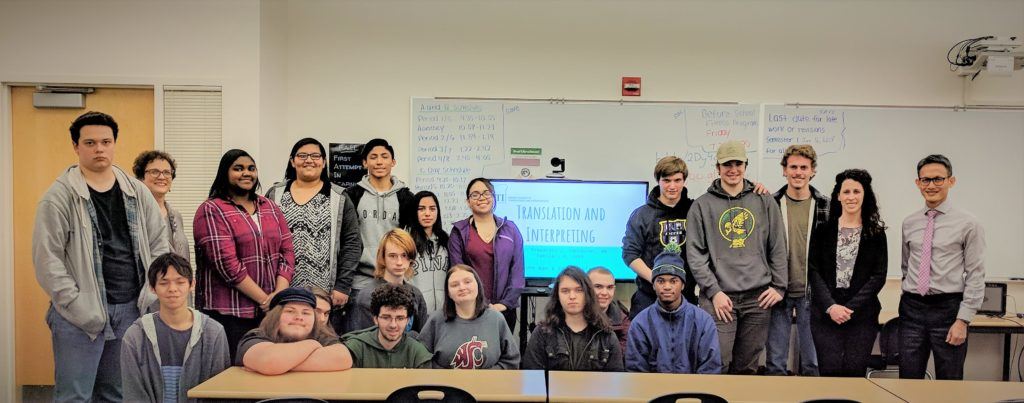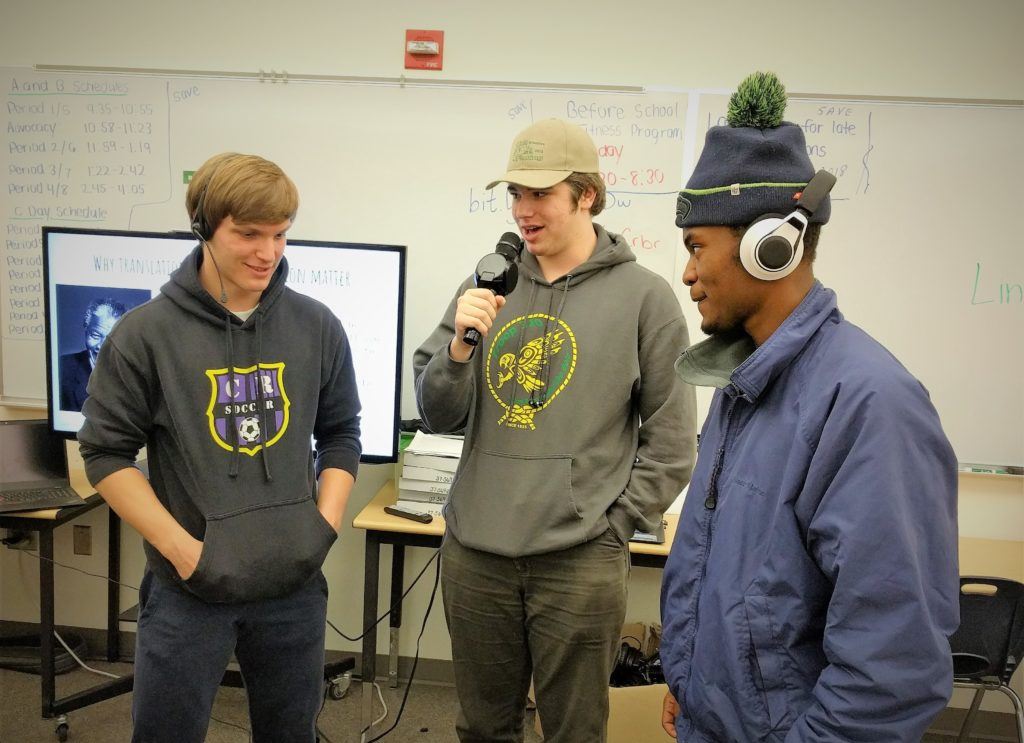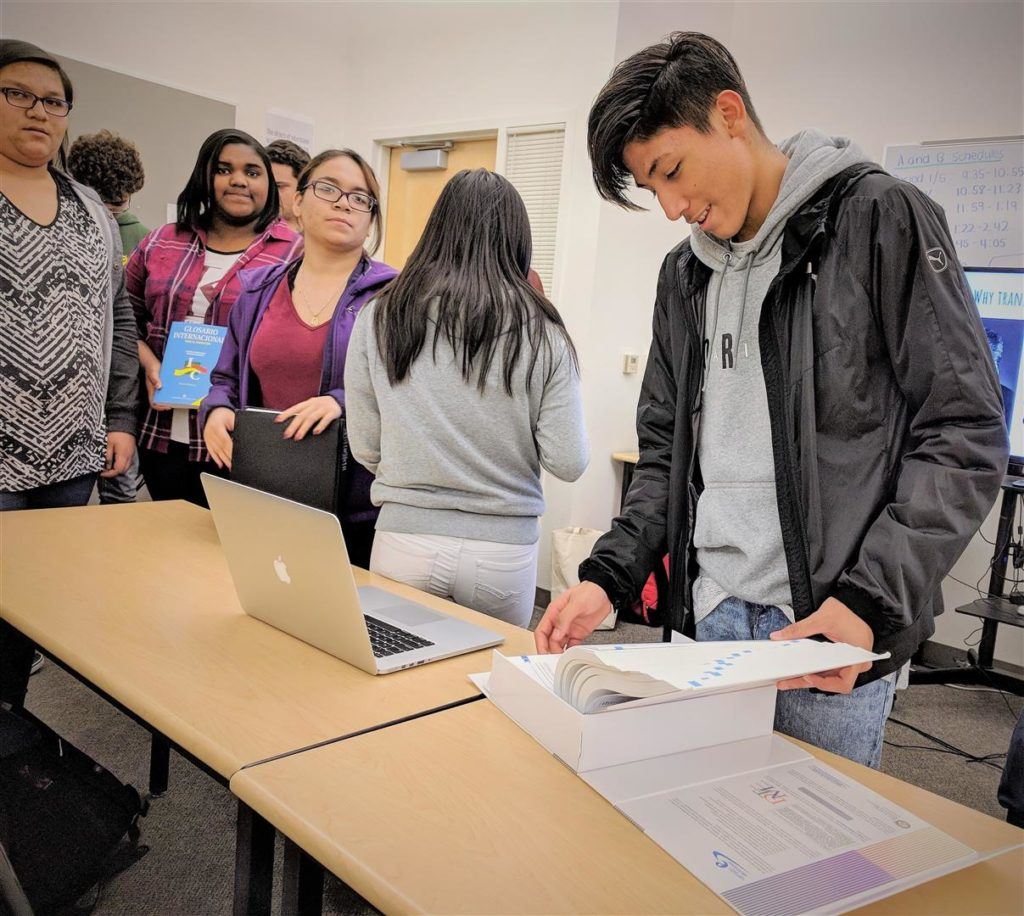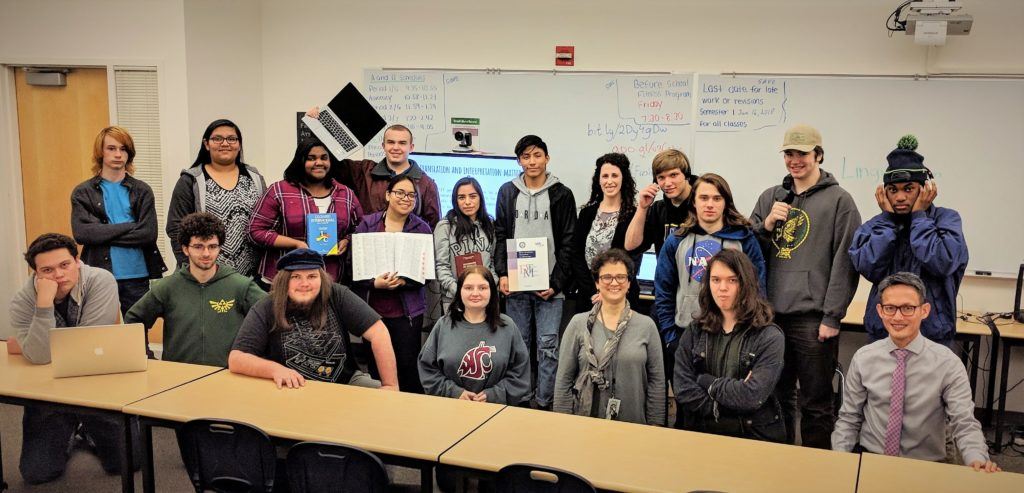
By Emily Safrin

I’ll admit it: despite my enthusiasm to accept an invitation to copresent on translation and interpreting (T&I) at a local high school, I was nervous. If my own high-school experience was any indication, surely the students could laugh us right off the figurative stage. Luckily, I couldn’t have been more mistaken.
At the invitation of a teacher at iTech Preparatory in Vancouver, Washington, fellow OSTI member and Membership Committee Chair John Wan and I prepared a presentation on T&I careers this past February. Our different paths complement one another well: John works as a Mandarin-language court interpreter, whereas I focus on Spanish-English medical translation and have also interpreted in health-care settings.
On the morning of February 8th, 2018, we drove to Vancouver to present. We were impressed to learn shortly beforehand that the class was completely focused on T&I. Nonetheless, we planned to open with a comparison of translation and interpreting—surely the natural place to begin for most audiences. But the students’ knowledge quickly exceeded our expectations: they had no trouble uniformly explaining the difference between the two professions. With that out of the way, we turned to a discussion of what it takes to be a translator or interpreter, centered around the question, “Is being bilingual enough?”
With the 2018 Winter Olympic Games having commenced just the day before, we used an Olympics-themed analogy to make our point, asking students, “What would it take for you to compete against Usain Bolt?” (These bright students needed no introduction, but for anyone unfamiliar: Bolt, who made his Olympic debut in 2004, is widely recognized as the greatest sprinter of all time.) It took no more than one response to cut to the chase: “Legs!”
Our point was that many things make Bolt the best in his sport, but without one vital “tool” in particular—his legs—none of those traits or skills would matter, because he wouldn’t even be able to set foot on the track. The same goes for T&I: to even attempt to perform the task, being bilingual is a prerequisite, but it hardly makes you the Usain Bolt of T&I. All it does is allow you to “compete”—that is, perform the task, however spectacularly or poorly you may perform. Put another way, without knowing at least two languages, you wouldn’t be able to even make an attempt at translating or interpreting, but just because you’re bilingual (or have legs) doesn’t mean you’re any good at the undertaking; it takes a natural adeptness and plenty of practice.

Having gotten this ubiquitous question out of the way, we talked about what it really takes to be a translator or interpreter and what the two different careers look like. We shared photos of the many settings where interpreters work: hospitals, court rooms, law firms, conferences, the United Nations, and via video remote interpreting. The photos of translation settings were somewhat less glamorous, mostly involving computers and dictionaries—but I assured them the task was no less enthralling, and I think by the end of the morning they were convinced!
With the necessary skills in mind, we asked students to try their hand at translating. To do this, we tied in the inevitable topic of machine translation (MT) by presenting students with a Spanish proverb and asking them to best suggestions by Google Translate and DeepL. The slide looked something like this:
Spanish proverb: A caballo regalado, no le mires el dentado.
Google Translate’s attempt: On a gift horse, do not look at the teeth.
DeepL’s attempt: On a gift horse, don’t look at the toothed horse.

In no time, a student provided the equivalent phrase in English: “Don’t look a gift horse in the mouth.” His classmates seemed duly impressed by their peer’s ability to easily one-up the highly touted MT engines, proving, albeit in a simplified sense, that human translators continue to serve an essential and as-of-yet irreplaceable role in intercultural and interlinguistic communication. (We were sure to address the usefulness of MT in given scenarios, but we also wanted students to recognize how their humanity sets them apart from the growing machine workforce.)
Following the translation activity, John described a typical day on the job as a court interpreter, and I explained my work as a self-employed translator, complete with commute from bed to desk. We also showed a clip from a Ted Talk on consecutive note-taking, with hopes to do an interpreting role play, but thanks to a flood of thoughtful questions throughout the presentation, we had to cut the agenda short.
Here are just a couple of the students’ questions:
- (After I showed them a photo of a frazzled woman at a computer representing the translator’s work environment): “What are some of the challenges you face when translating?”
- “How long are you given to complete a translation project?”
- “What do you charge for a translation?”
- “What dictionaries do you use? Have you heard of Context Reverso?” (I had not, but I’ve since compared it to Linguee, with interesting results.)

Finally, we quickly touched on certification, education, and training opportunities in T&I, as well as professional organizations (including OSTI, of course!).
When it came time for photos, we asked students to choose a prop that represented the profession they were most interested in from items we had brought (dictionaries and laptops were to symbolize translation and microphones and headsets symbolized interpretation). There were more budding translators than interpreters, but the interpreters made up for this in their delight with the interpreting equipment.
By the time we left, I forgot that I had even been nervous beforehand. I felt exhilarated—not to mention enthusiastic about the future of T&I. Seeing students so engaged with our work reminded me of how lucky I am to love what I do, and I returned to work that afternoon with a renewed sense of pride and satisfaction.
The following day, I shared our materials with the teacher via email. She sent thanks and a reflection on the impact of our talk, which meant as much to me as I’m sure it did to her: “When I saw my least motivated heritage student pick up the biggest dictionary, I knew she was inspired to be a translator because of you.”
Needless to say, we’re grateful to have had the chance to spend time speaking with the translators and interpreters of tomorrow, and we look forward to seeing other OSTI members do the same. If you’re interested in participating in school outreach, drop us a line!